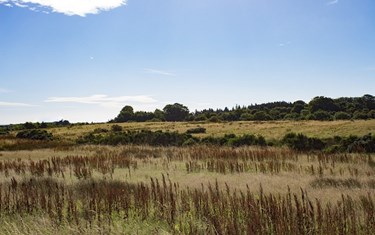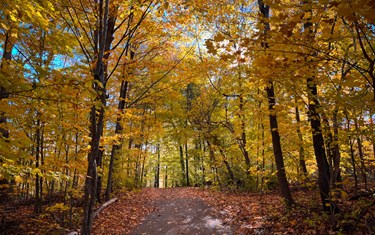Currently, a Tree Preservation Order (TPO) can protect a single tree, or a group of trees, if they are deemed important for an area's appearance. When a tree, or group of trees, is protected by a TPO it means permission must be sought by either the local authority, or the Department for Infrastructure, before cutting or pruning the tree. Breaching a TPO is a criminal offence which can carry a fine relative to the severity of the offence.
A 2023 report by the Northern Ireland Public Services Ombudsman on tree protection in the planning system found that, despite 369 tree protection breaches reported between 2019 and 2022, only one resulted in enforcement action being taken, and none led to prosecution.
Peter McReynolds MLA has proposed to strengthen TPOs through various measures in a Private Member’s Bill, including introducing 'ecosystem services' as an additional attribute for making a TPO, and updating the Planning Act (Northern Ireland) 2011 to make it an offence to 'cause or permit' the breach of a TPO.
Members of the RTPI NI Policy and Research Forum voted that RTPI NI should respond to this Private Member’s Bill. Our response is below.
Section 1: Strengthening Existing Legal Protections for Trees
Did you know about TPOs as a mechanism for protecting trees?
Yes
How effective do you think TPOs are for protecting trees and groups of trees?
Somewhat effective
Do you have any further thoughts about the current system for protecting trees and groups of trees?
TPOs are a useful and well utilised tool in the planning system. Specified trees can be protected through a TPO, which requires a statutory process to be undertaken in accordance with planning legislation. In addition, trees that are within a Conservation Area also enjoy a level of protection. However, there is sometimes confusion between TPOs and planning conditions on development/ planning permissions. Planning Officers should have the resources and understanding required to deal with issues of tree protection and to know which mechanisms are best in each circumstance.
Prior notification and/or consent is required from the Council before any works are undertaken to protected trees. All requests for a TPO are considered by the Planning Service and can be submitted via the planning portal. In addition, the Council itself may initiate a TPO when necessary, for example, as a result of a planning application where there may be a significant threat of felling. The assessment of prospective TPOs is based on a number of key considerations set out in legislation. These include trees of special value in terms of amenity, history or rarity, which may be under threat. Other considerations include the health of the trees, public health and safety issues, and the implications for ongoing tree management.
The statutory process for the serving of TPOs includes notification and legal procedures, as well as obtaining an expert detailed survey. The process is not designed to provide blanket TPO coverage as it must be applied to specified individual trees or tree groupings. Whilst a TPO can give protection to specified trees, it does not obligate any particular tree management measures, which is something that could be considered in any new legislation.
In addition, the TPO process and the consequent consenting process, alongside the ongoing review programme, are time and resource intensive. Local Council planning departments are already stretched. RTPI NI believes that the singularly most effective change that could come in would be better resourcing of planning departments with specialist tree officers, and/or upskilling of planning officers (including enforcement officers) to deal with TPOs in a timely and thorough manner. This would include appropriate enforcement action and penalties to ensure that the system is not bypassed or abused. It would be useful, as part of this Bill, to gain detail from Local Planning Authorities as to how many TPOs they deal with per month, do they have a dedicated tree officer, and what evidence is there of all enforcement cases relating to unauthorised works to protected trees and how those cases were resolved e.g. closed as not expedient, prosecution. This would support the case for where resource is needed.
Most Councils have online TPO maps showing all protected trees in their council area, which helps clarify the process for planning consultants and developers. However, not all Councils have this to offer. This is a helpful resource which could be mandatory.
Do you support adding 'ecosystem services' as an additional attribute for making a TPO to protect trees or groups of trees?
Yes
Do you have any further thoughts on which benefits trees provide (ecosystem services) should be considered when making a TPO?
The link between trees and flooding is a strong one, which should be considered in areas with flood risk. As we increasingly see the impact of climate change, trees play an important role in climate resilience such as helping soil integrity, water drainage, reducing the urban heat effect and improving air quality. However, it can be argued that legislation is already fit for purpose in this regard. Section 122 of the Planning Act 2011 enables the making of a TPO where “it appears … that it is expedient in the interests of amenity”.
Some Councils, in their published guidance on TPOs, have detailed this further. For instance, Belfast City Council acknowledges that “trees can have a high amenity value and can make an important contribution to the environment….provide wildlife habitat and contribute to the health and wellbeing of humans.” The guidance also sets out the key considerations when deciding to protect specific trees with a TPO: a) Potential Threat: priority is given to the protection of those trees deemed to be at immediate risk from active felling or damage from development on site. b) Visibility: the extent to which the trees or woodlands can be seen by the general public will inform the assessment of whether the impact on the local environment is significant; c) Individual Impact: the fact that a tree is publicly visible will not itself be sufficient to warrant a TPO. The tree’s particular importance is assessed by reference to its size and form. Its future potential as an amenity is also assessed, taking into account any special factors such as its screening value or contribution to the character or appearance of an area. In relation to a group of trees or woodland, an assessment is made of the collective impact; d) Wider Impact: The significance of the trees in their local surroundings is assessed, taking into account how suitable they are to their particular setting, as well as the presence of other trees in the vicinity; e) Historical Importance: Certain trees, because of their age, association with the setting of listed buildings or the contribution they make to the special character of a conservation area may require consideration for TPO protection; and f) Rarity: There may be occasions where a tree(s) may be considered for TPO protection solely on the grounds of its rarity. The priority of the consideration will reflect the rarity of the species.
Therefore, some Councils, such as BCC, already recognise the potential ecosystem services benefits of trees. However, it is accepted that the definition of ‘amenity’ is open to interpretation and can sometimes be applied narrowly and may not specifically include some of the wider benefits of trees and woodland. As is often the case in planning, there is a question of balance and the need for informed decision making. It is ultimately the decision of each planning authority whether to pursue a new TPO. As noted above, this would be best addressed by dedicated arboriculturist resource in each LPA, or at least the upskilling of planning officers to have the knowledge to make informed decisions. A clearer interpretation in legislation setting out how ‘amenity’ can be defined, would also be beneficial.
Under English law, the Town and Country Planning Act 1990 makes it an offence to ‘cause or permit’ the breach of a TPO. In Northern Ireland, the Planning Act (Northern Ireland) 2011 addresses only causing a breach, referring to ‘any person, in contravention’ of a TPO. However, the subordinate Planning (Trees) Regulations (Northern Ireland) 2015 expand this to include both causing and permitting a breach, creating a significant discrepancy between different pieces of legislation.
Do you support updating the Planning Act (Northern Ireland) 2011 to make it an offence to cause or permit the breach of a TPO?
Yes
Do you have any further thoughts on making it an offence to cause or permit the breach of a TPO?
If the Planning Act is revised, there will be more time and resource required in proving that a person caused or permitted a breach. Local Planning Authorities will need the necessary resource to pursue these cases and gather the evidence required.
Do you support the requirement to plant and maintain a tree if a TPO has been breached?
Yes
Do you have any further thoughts on the requirement to plant and maintain a tree if a TPO has been breached?
This must not just be a tick-box exercise, but the tree planted must be of an appropriate species, level of maturity and in an appropriate location. Tree experts must be consulted.
Section 2: Heritage Trees
Unlike our oldest and most significant buildings, most of our oldest and most significant trees are not legally protected. In Northern Ireland, there are over 2,000 recorded ancient and veteran trees. A major concern is stopping the loss of these trees due to development and neglect because, once they are lost, they cannot be replaced.
A Tree Protection Bill would propose Northern Ireland's oldest and most significant trees could be designated as 'Heritage Trees'. These would be identified and listed because of their age, ecological value, historical, or cultural significance. Once designated as Heritage Trees, they would receive similar protections to trees under a TPO. Local councils would be responsible for issuing Heritage Tree Protection Orders, ensuring there are strict measures to prevent any unauthorised removal or damage.
Do you agree with the creation of a new heritage tree designation to protect our oldest and most significant trees?
Neither agree nor disagree
Do you have any further thoughts on the creation of a new heritage tree designation to protect our oldest and most significant trees?
As with other TPOs, consideration needs to be given to how the new designation would be enforced and the level of penalty issued. Consideration must also be given to how to look after/maintain heritage trees to try to prevent damage to the tree itself and the surrounding area. In addition, when considering ‘oldest’ trees, it is important to consider the age of an individual tree relative to what is expected of the species. Clarification may be required in terms of individual tree species being considered for this designation.
The existing mechanism for TPOs could be used to protect important heritage trees, so it is unclear what benefit this new mechanism would provide, and it may add a significant workload to Councils through even the designation process itself. This designation process might compete in terms of resourcing with the TPO process, unless significant resource is made available to local Councils to implement both.
Please rank the criteria you think should be used to determine whether a heritage tree qualifies as a heritage tree, from 1 being the most important to 4 being the least important.
- Age
- Ecological value
- Historical significance
- Cultural significance
Heritage Tree status would introduce 'Heritage Tree Partnership Agreements' which would encourage co-operation between tree owners and responsible organisations to ensure the best care and maintenance of important trees. These agreements could include small grants or advice to help protect them for future generations.
Do you agree with the proposal to support landowners who have heritage trees on their property?
Yes
Do you have any further thoughts on the proposal to support landowners who have heritage trees on their property?
As noted above, designating a heritage tree must not just mean the tree is left alone – care and maintenance by specially trained arboriculturists is crucial to protecting these important trees. The cost of providing advice and grant aid will require adequate resources, which might need to be undertaken by DAERA rather than local Councils.
What kind of support do you think should be provided to landowners who have heritage trees on their property?
Expert advice on tree care rather than financial incentives
If other, please specify what support you think should be provided to landowners who have heritage trees on their property.
If a government department proposes to take the heritage tree designation forward across Northern Ireland, then it should be adequately resourced. The provision of general or specific tree management advice would clearly be useful but has significant implications for resources. The provision of grant aid has even greater implications for resources and budgets, including in grant administration and follow up verification. These implications need to be considered before any legislative changes.
Section 3: Safeguarding Ancient and Long Established Woodland
Ancient woodland, which has been around since the 1600s, and long-established woodland, which dates back to at least 1830, have developed unique and complex ecosystems over time. These woodlands are shaped by factors like the type of soil, the local climate, and how people have interacted with them. Ancient woodland makes up just 0.04% of Northern Ireland's landscape, and once it’s gone, it cannot be replaced.
Permitted developments allow specific works by statutory undertakers like utilities or telecoms without formal planning permission. A Tree Protection Bill would propose adding ancient and long-established woodland, legally protected trees (those with a TPO) and heritage trees, to the list of criteria in which development is not automatically permitted. This measure would provide these irreplaceable assets with the same protection as Areas of Special Scientific Interest or sites of archaeological interest to ensure they will not be lost to development without the necessary authorisation.
Do you support the proposal to restrict permitted developments from sites with ancient and long-established woodland, legally protected trees and heritage trees?
Unsure
Do you have any further comments on protecting ancient and long-established woodland, legally protected trees and heritage trees from permitted development?
More information is required as to how ancient and long-established woodlands and heritage trees may be designated and by what authority. In principle, the removal of permitted development rights where the proposal would damage or result in the loss of a protected tree is supported. However, where a TPO is in place, consent is still required for works to the protected trees irrespective of whether the proposed development is permitted development, so it is unclear what benefit this additional proposal would bring, yet it would significantly increase the resource requirements of LPAs as a significant increase in planning applications would likely result.
Do you support the proposals to require developers to prove that there are no other viable options for development in cases where development would result in the removal or alteration of ancient and long-established woodlands, and heritage trees?
Yes
Do you have any further comments on the proposed requirements for developers?
Planners and the planning process are key to protection of these important assets. In England and Wales, many Councils have their own arboriculturists to comment on and inform planning policy and planning applications. The same would be advisable here, or at least the special training of planning officers to empower them to make more informed decisions and be more confident in negotiations about trees.
The Local Development Plan process would be key to any changes in the designation process for tree protection, but again this would require the resource and upskilling required of planning officers. Belfast City Council’s Local Development Plan already includes a policy to protect trees from new development.
When balanced against the benefits of this legislation, do you think that any cost of implementing and enforcing the proposed bill is acceptable?
Don't know
Other (please specify)
There is not enough detail as to what the financial cost is likely to be, who will cover it, and if the benefits of any changes to the tree preservation process are substantially different to the current TPO process (if it was adequately resourced).
Which of the following options do you believe these proposals will positively benefit:
The Environment
The Climate
Biodiversity
Public Health
Other (please specify)
Landscape character
Do you have any additional comments on the proposed legislative changes to enhance the legal protection of trees and ancient/long-established woodland in Northern Ireland?
RTPI NI welcomes the recognition of the value and importance of heritage trees and ancient woodland in this consultation. Trees are vital to the health, wellbeing and character of the places in which we live, work and play. However, more detail is required as to how the proposed legislation goes over and above TPOs, who would implement it, and who would cover the cost. This does not appear to be an issue requiring legislation - just better guidance and better practice in Councils. An alternative approach would be to focus on the provision of dedicated tree officers to support each Local Planning Authority, in order to properly and efficiently administer the current Tree Preservation Order process within the planning system.


